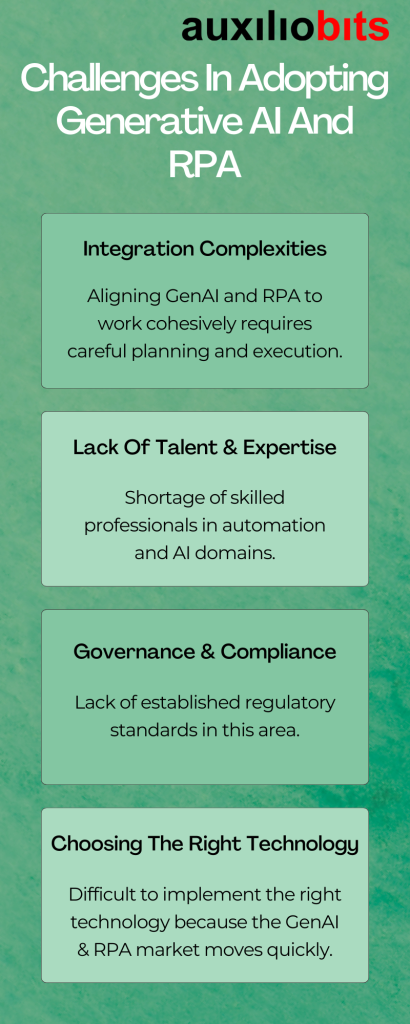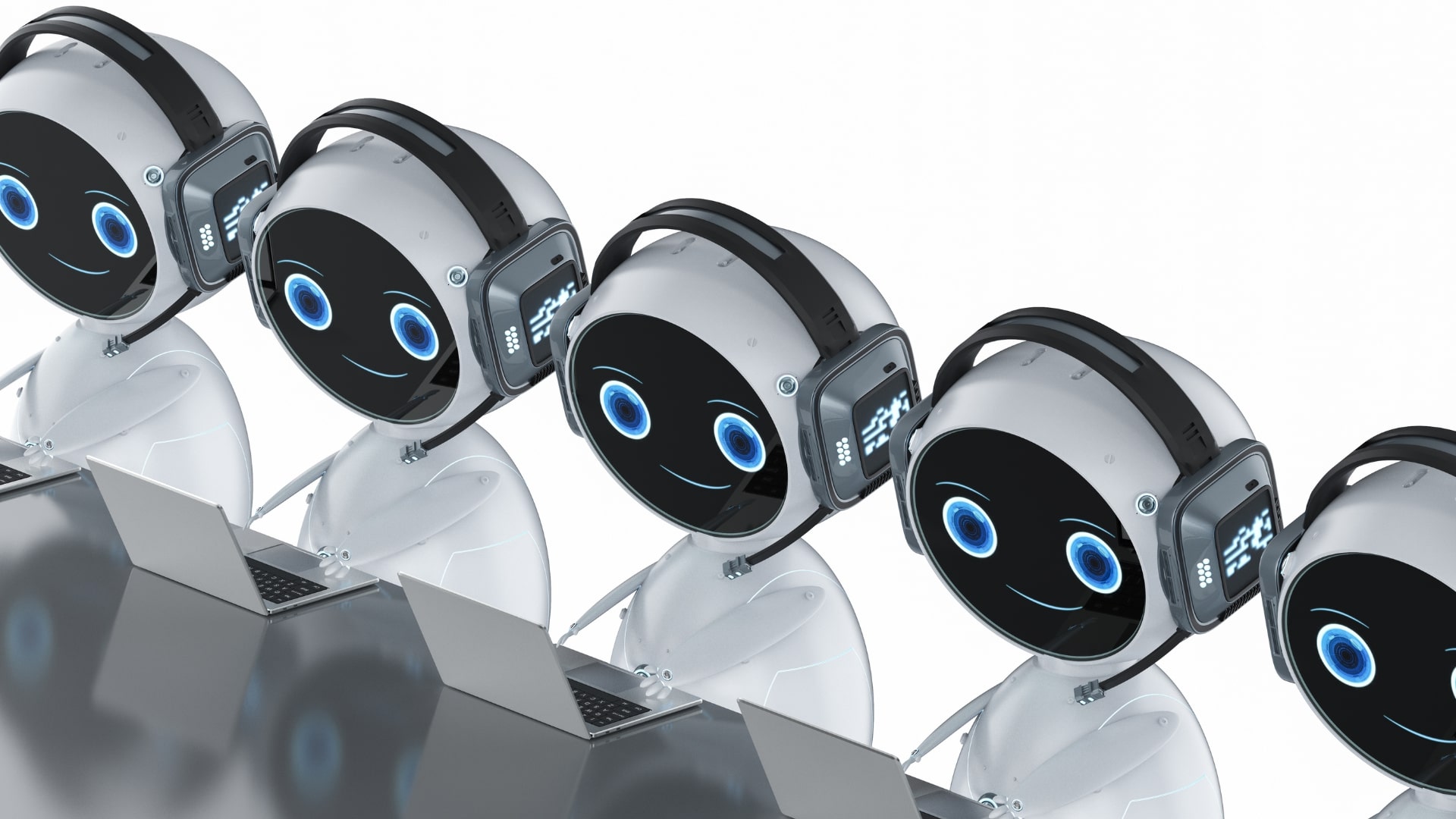
Key Takeaways
- Two key technologies leading the way for digital transformation are generative artificial intelligence (AI) and Robotic Process Automation (RPA) - they are changing the game for organizations.
- When RPA and GenAI work together, businesses can automate tasks that used to require human thinking and open up various new ways to automate things.
- Gartner's 2023 Magic Quadrant™ for RPA also predicts that by 2025, 90% of RPA vendors will offer generative AI-assisted automation.
- Combining generative AI and RPA enhances operational efficiency, improves customer experience, provides data-driven insights, and more.
- In the past, only repetitive tasks were automated. Howevr, GenAI is changing this by handling tasks we thought only humans could do, like legal research, medical diagnostics, financial analysis, and more.
- Implementation of GenAI and RPA requires careful planning to integrate them seamlessly into the current systems and decision-making processes.
In a time where staying ahead means going digital, businesses are looking to advanced technology to improve how they work, keep customers happy and find new ideas. Two key technologies leading the way are generative artificial intelligence (AI) and robotics process automation (RPA) – they are changing the game for organizations.
We’re entering a new era of work, where technology is reshaping how we do things, making us more efficient, productive and creative. Leading this change is Generative AI, an innovative force ready to transform how we create and manage content across different industries.
- How Generative AI And RPA Help Business Grow?
- Trends In Generative And RPA | Future Outlook
- Benefits Of Adopting Generative AI And RPA
- How Generative AI & RPA Technologies Are Reshaping Job Roles And Workflows?
- Challenges In Adopting Generative AI And RPA
- Practical Applications & Innovative Use Cases
- Conclusion
How Generative AI And RPA Help Business Grow?
When combined, generative AI and RPA can make automation smoother, which doesn’t just make things work better, but also helps come up with new ideas. When these technologies work together, businesses can automate tasks that used to require human thinking and open up various new ways to automate things.
The core of judgment-based tasks is their need for decisions based on human judgment and expertise. Across various industries, this covers multiple activities like simplifying tasks, managing reports, fraud detection and compliance monitoring. For example, Generative AI can examine large datasets, spotting subtle patterns and connections that help make accurate risk assessments.
Trends In Generative And RPA | Future Outlook
In 2024, the RPA market will face significant changes due to various key trends. These include the impact of AI on RPA, shifts in the market landscape, changes in RPA’s role within the broader automation framework and new data management methods. Whether you want to reduce manual tasks for your team, get more from your automation program, or simply learn about the future of RPA, these evidence-based trends and expert predictions will help you know what to expect in the coming year.
RPA Enhanced by AI
AI will be the top trend in 2024 for most tech areas, including RPA. (The robots might be worried about their jobs right now.) According to Gartner’s 2023 Critical Capabilities for Robotic Process Automation report, almost every RPA vendor has tried, or plans to try, using GenAI (like GPT models) in their products or is adding connections to popular GPT providers. These trials will likely turn into real products in 2024. (Source: Gartner)
Gartner’s 2023 Magic Quadrant™ for RPA also predicts that by 2025, 90% of RPA vendors will offer generative AI-assisted automation. (Source: UiPath)
What might “generative-AI-assisted automation” look like? AI will likely make it easier for developers to create bots with features like guided navigation and chatbot help. You’ll also see AI improving the bots themselves. The bots will get better at:
Handling unexpected situations like humans (current bots often fail when their environment changes).
Understanding messy or unstructured data.
Making decisions based on context.
Generative AI will also help bots create workflows automatically based on the data they receive. Some software, like Appian RPA, already lets developers record their tasks in a browser and use RPA to design a workflow for automation, but AI could make this process even easier.
Ongoing RPA Market Consolidation
The RPA market isn’t experiencing significant growth, but it is consolidating and becoming increasingly competitive. Gartner’s 2023 Critical Capabilities for Robotic Process Automation report says:
Despite slower growth, the RPA market is still evolving quickly. As of January 2023, there are over 60 vendors worldwide, but the market is becoming more consolidated and competitive. Large software companies are entering the market, and dedicated RPA vendors are fighting hard to be on top and make their products better. (Source: Gartner)
Forrester describes the RPA market as facing a big decision point. They mentioned that
“Many of the big RPA companies have been making their products better for a long time and now want to do more than just RPA. They are trying to do this by making their products bigger and by buying other companies, which makes their range of products even more complicated. Because of changes like these, where RPA is becoming more common and simpler, Forrester thinks that the cost of using it will go down.” (Source:Forrester)
RPA Becomes a Built-in Feature
As a natural outcome of the trend toward consolidating the RPA market, companies are using and buying RPA less as a separate tool and more as part of a bigger automation system. Businesses now prefer automation tools that smoothly fit in with existing systems, are easy to maintain, and don’t need specialized skills to handle. This unified approach stops separate pockets of automation from forming (and helps IT teams connect gaps when these pockets already exist). Here’s Gartner’s assessment
RPA vendors are either introducing new products to their lineups or being acquired to create more versatile task and process automation platforms with enhanced capabilities.
While this might sound simple andhelpful, it can also be confusing for buyers. Forrester explains:
RPA buyers have to navigate these choices while trying to achieve two things: making their RPA setups bigger and more industrialized, and incorporating them into the wider mix of automation technologies known as the automation fabric.
(Source: Forrester)
Improved Data Support for Bots
Just like any other digital tool, robots work with data and should be able to access it easily. They shouldn’t have to worry about how data is organized, how to control who can access it and how to make sure it’s accurate when adding new data. In 2024, these concerns will be taken care of and included in how robots access data. The best robots will use a data platform that brings together different data sources into one organized system with clear rules.
Because people are realizing more how important it is to keep data organized and accurate for RPA, companies will create better systems to manage data. These systems will define how different data sources relate, follow rules to change or check data and control who can access it.
Movement Toward AGI and Related Research
Artificial general intelligence (AGI) is a popular topic among AI companies today. AGI refers to AI reaching a level where it can outperform humans in most tasks and critical thinking. However, so far, it remains mostly a concept.
Google’s Deepmind is one of the key players in this field, along with OpenAI, Meta, Adept AI and others. Currently, there’s little agreement on what AGI is, what it will look like, and how AI leaders will determine if they have achieved AGI.
So far, most AGI research has been done in isolation. In the future, AGI will remain a top priority for research and development. However, like other major tech and AI projects in the past, it will likely become more collaborative, mainly to develop a clear definition and framework for AGI. While true AGI might not be achieved in the near future, generative AI will continue to get closer to this goal as AI companies work to define it more clearly.
Benefits Of Adopting Generative AI And RPA
Combining generative AI and RPA is a big innovation for various fields such as financial services, the healthcare industry, banking insurance, retail business, etc., which promises better operations, customer service and decision-making.
Operational Efficiency
Automating routine tasks allows employees to focus on more strategic and valuable activities, which lowers operational costs and increases productivity.
Improved Customer Experience
Generative AI can customize interactions and services, which provides a better customer experience that increases loyalty and boosts revenue.
Data-Driven Insights
The combination of RPA and Generative AI can process and analyze vast amounts of data more effectively than traditional methods providing deeper, more actionable insights for better, more impactful decision-making.
How Generative AI and RPA Technologies Are Reshaping Job Roles And Workflows?
As technology keeps changing, GenAI and RPA are reshaping how we work in many industries, including small and medium-sized businesses. Automation used to be just for repetitive tasks, but GenAI goes further. It can transform routine work and also help with creative and knowledge-based tasks. It has caught the attention of business leaders, who are now exploring how to use generative AI and RPA in different areas.
To harness the power of GenAI effectively, companies need to rethink jobs and processes. This means breaking down jobs into smaller tasks, figuring out which tasks can be automated or improved with AI, and then changing processes to fit these new jobs smoothly.
In the past, jobs with repetitive tasks were seen as most likely to be automated, while creative and complex jobs were considered safe. But GenAI is changing this by handling tasks we thought only humans could do, like legal research, medical diagnostics and financial analysis. Companies should invest in training and new skills for their employees to perform well in an AI-driven workplace.
Challenges Of Adopting Generative AI And RPA

Despite these benefits, you have to deal with some challenges when putting these technologies into practice. It requires careful planning to fit them smoothly into the current systems and decision-making processes.
Integration Complexities
Making Generative AI and RPA work smoothly with current business processes needs careful planning and execution to prevent problems and give enough time for change management.
Lack Of Talent and Expertise
Finding enough skilled professionals in AI and automation can make it hard to put these technologies into action successfully.
Governance and Compliance
It is important to note that there is a lack of established regulatory standards in this area.
Choosing The Right Technology
The generative AI and RPA market moves quickly, which makes it hard to decide where to invest or make strategic decisions.
Practical Applications and Innovative Use Cases
Automated Customer Support with a Human Touch
Generative AI is quickly changing customer support by providing instant responses through live chat, phone calls, and emails. Businesses can fully automate customer service and use AI to help human workers. Smart assistants can handle tasks like searching for information, summarizing calls and analyzing call transcripts. This allows customer support managers to find common problems, identify areas where service needs improvement, and use feedback to make products and services better.
For example, Expedia Group, known for platforms like Hotels.com and Vrbo.com, integrated ChatGPT into the Expedia app. Instead of searching for flights and accommodations on the website, users can ask the AI-powered assistant for travel advice just like they would with a travel agent. ChatGPT can recommend travel destinations, hotels, and transportation. Users can then bookmark these suggestions in the app and check availability on selected dates.
Content Marketing That Gets Real Results
Marketing departments have benefited a lot from generative AI. It makes tasks like recommendation engines and ad placements more effective. Most generative AI in marketing focuses on creating content. Gen AI can quickly write relevant and coherent content on any topic, while human writers might take hours to do the same.
It’s no surprise that Gen AI now creates 25% of all digital content. (Source: Market Splash). Smart brands use generative AI tools to write and edit social media posts, blog articles, product descriptions, sales emails, and presentation text. Some even cut costs by reducing their in-house writing staff. But, there are some challenges. Large language models (LLMs) can sometimes make mistakes or present false information because they are trained on data that might be incomplete or incorrect. While tools like ChatGPT can now access real-time search results, the results might still be incomplete or off-topic.
Business Process Automation That Adds Value
Most business tasks are made easier with automation tools like robotic process (RPA) and intelligent process automation (IPA). Generative AI in business is the next step after IPA. It helps with tasks like analyzing data, creating new content, saving time by automating complex tasks and giving smart advice to employees.
Generative AI is more advanced than other automation tools because it understands natural language. It helps with many processes, such as:
- Managing tasks, scheduling meetings, and organizing emails
- Finding accurate information and summarizing it in simple words
- Making documents and reports automatically
- Putting data into technology systems
According to McKinsey, using generative AI strategically can automate up to 70% of tasks that take time for employees, which makes businesses much more productive. (Source: McKinsey)
Conclusion
Combining generative AI and RPA is more than just a technological upgrade; it changes what automation can do. RPA can take care of simple, repetitive tasks, while generative AI handles more complex, thinking tasks.
By knowing the facts and following the tips mentioned earlier, this combination can help businesses build a more complete, flexible, and strong automation system. Working with an automation partner helps you overcome automation challenges and leverage the power of technology effectively!
Connect with the experts at Auxiliobits for a seamless automation journey!
Call us Now!






